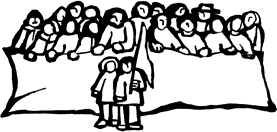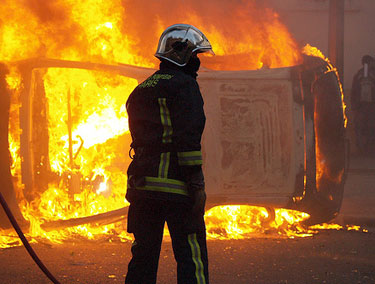resources

Flickr Riot
I’m late to the party on this, but as one of its co-founders notes in passing, the photo sharing site Flickr is fast becoming an easy way to find photos of major protest events in wired urban areas. See for instance, protests this week against the CPE in Paris or the election in Belarus. See also this December 2005 story on MoveOn’s use of Flickr or the 1,430 photos tagged “RNC.”
If Web 2.0 is made of people, an easy use is a kind of grassroots media. Though the corporate-owners of such Web frameworks are certainly willing to take down images that “may offend” or hand over the goods on users. (via)
Cut and Paint

Cut&Paint is a zine of stencil templates, ready to cut, ready to paint.
Volume two is in the works with a deadline for submissions on February 20, 2006. In addition to stencils, the issue will include a how-to section, photos of stencils on site, and articles on stenciling, public space, and politics. Check the submission criteria.
The first issue is nearly sold out of its run of 400 copies, so I helped the team post the stencils online. It’s a quick and basic site for now, but will evolve as we add more images. The first 41 stencils are up and ready for download at http://cutandpaint.org.
Guide to Recycled and Ecological Papers
 Via that same issue of Print I found this interesting matrix of recycled and tree-free papers assembled by Celery Design. About the guide:
Via that same issue of Print I found this interesting matrix of recycled and tree-free papers assembled by Celery Design. About the guide:
“Most graphics professionals are searching for a few simple things in a paper the highest quality, the easiest functionality, and the lowest price. The goal of this guide is to help you add one more critical consideration to the decision making process: the environmental impact of the paper you specify.
Through your paper choices, you are directly connected to the preservation or the degradation of land, water, air, and the creatures that dwell therein. Paper reps and printers provide guidance on finding the best quality, functionality and price, but often can’t help when it comes to preserving the environment. This guide fills that information gap and points you to the very best recycled and tree free papers on the market today. You will discover that most of these papers are also very competitive in terms of quality, functionality, and price.
The recycled and tree-free papers listed here generate fewer toxins and impact the environment far less than typical virgin wood, chlorine-bleached papers. There are options here in nearly every grade, format and price category. We encourage you to contact the paper manufacturers for samples, pricing, and ordering information, and work with your clients and printers to specify these papers. We developed this guide as an easy-to-use, practical tool that makes it simple to change old paper-buying habits. Use it and share it with your friends. With the right information and a bit of initiative, each of us can reach a higher standard for our graphics projects.”
It’s not clear when the guide was last updated, but do bookmark the page at http://www.celerydesign.com/paper/matrix.html
What’s missing from the list are more tree-free, “synthetic” alternatives to paper like:
- TerraSkin, a biodegradable paper made of mineral powder.
- Yupo, made of 100% polypropylene. Not biodegradable, but easy to reconstitute.
- NatureWorks PLA, a biodegradable corn-derived polymer, primarily used for packaging.
Anyone know of other good resources on alternatives to paper?
...
Update July 27, 2005:
More suppliers of tree-free and recycled papers are listed at Rainforest Web
Update August 28, 2005:
The San Francisco AIGA’s Ecological Guide to Paper lists 20 papers that are either 100% recycled, tree-free, or some combination of both
Update October 31, 2005:
Conservatree has lots of good information:
They also offer consulting services.
For more on changing your organization’s paper policy, see the Environmental Paper Network’s Environmentally Preferable Paper Purchasing Guidance (436 Kb PDF).


